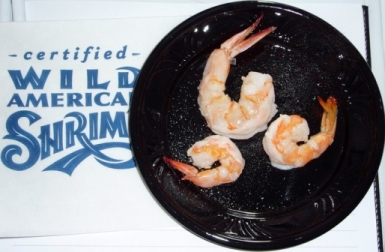Shrimpers Solve Geographic Indication Problem by Registering Certification Mark
On January 21, Seattle Trademark Lawyer discussed an ad reminding consumers that true Champagne wine comes from the Champagne region of France. The post pointed out that the success of such campaigns is limited by the often fuzzy definition of unregulated growing regions. Washington State, for example, has no defined “appellations” for its prized oysters, even though consumers may make purchasing decisions based on where they think their oysters came from.
Wild American Shrimp, Inc., argues the same is true with shrimp. Its Web site paints a familiar picture:
“You have a table for two, overlooking the water. You order the shrimp skewers. After all, the shrimp boats are right at the dock, you’re probably eating their catch, right? Not necessarily. The fact is, 85% of the shrimp you eat is imported, and most likely pond-raised. Even in the Gulf and South Atlantic states, most restaurants, grocery stores and seafood markets carry imported shrimp. You’ve been tricked. Your shrimp was raised in a pond, then shipped overseas — and you had no idea.”

That may soon change. On January 25, the U.S. Patent and Trademark Office granted Wild American Shrimp a certification mark for WILD AMERICAN shrimp (announcement here). Certification marks are types of trademarks that indicate that goods produced by others meet certain standards, which can include that they came from a particular region. Wild American Shrimp, which now owns Reg. No. 3,199,175, uses WILD AMERICAN to certify shrimp as being caught “in their native habitat in the coastal waters of the Gulf and East Coasts of the United States.”
As Wild American Shrimp puts it:
“Certified Wild American shrimp are caught by shrimpers off the Gulf and South Atlantic Coasts. To be more exact: Texas, Louisiana, Mississippi, Alabama, Georgia, South Carolina and North Carolina. The shrimp naturally thrive in these waters, and their presence has influenced a way of life in these states. Instead of being scooped from a pond and shipped over on a container ship, Wild American shrimp are pulled directly from their natural environment, delivered to the dock, then to your table.”
Is this the next step for oysters? Washington vintners can enforce claims that their grapes are grown in the Yakima Valley, Columbia Valley, Walla Walla Valley, Puget Sound, Red Mountain, Columbia Gorge, Horse Heaven Hills, Wahluke Slope, and Rattlesnake Hills Viticultural Areas. It’s a lot more difficult for Washington shellfish growers. Will we someday see registered certification marks for oysters grown in defined parts of Hood Canal, Penn Cove, Baynes Sound, Willapa Bay, and the Straits of Juan de Fuca? It would make trademark infringement and false designation of origin claims a lot easier to prove, strengthening brands, and adding even more value to Washington’s home-grown delicacies.
(Photo credit: Auggieland food blog)
Reader Comments